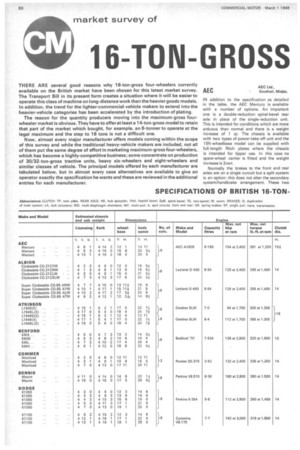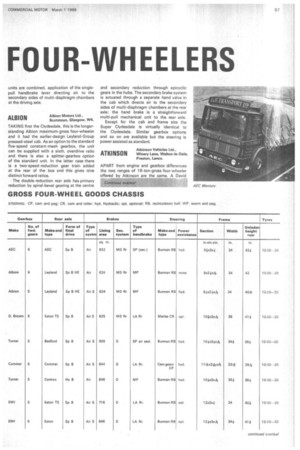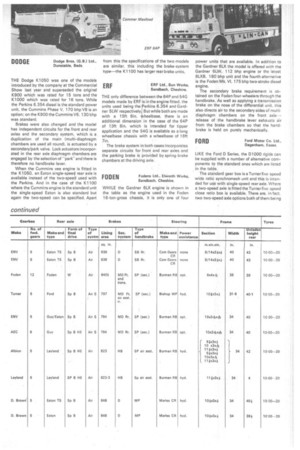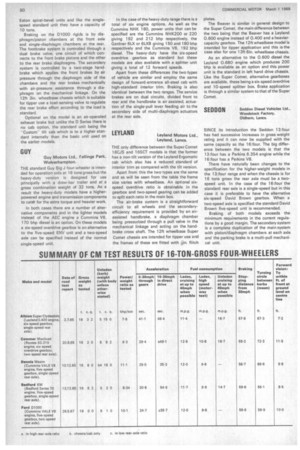16-TON-GROSS FOUR-WHEELERS
Page 88

Page 89

Page 90

Page 91

Page 92

If you've noticed an error in this article please click here to report it so we can fix it.
THERE ARE several good reasons why 16-ton-gross four-wheelers currently available on the British market have been chosen for this latest market survey. The Transport Bill in its present form creates a situation where it will be easier to operate this class of machine on long-distance work than the heavier goods models. In addition, the trend for the lighter-commercial-vehicle makers to extend into the heavier-vehicle categories has been accelerated by the introduction of plating.
The reason for the quantity producers moving into the maximum-gross fourwheeler market is obvious. They have -to offer at least a 14-ton-gross model to retain that part of the market which bought, for example, an 8-tonner to operate at the legal maximum and the step to 16 tons is not a difficult one.
Now, almost every major manufacturer offers models coming within the scope of this survey and while the traditional heavy-vehicle makers are included, not all of them put the same degree of effort in marketing maximum-gross four-wheelers, which has become a highly-competitive business; some concentrate on production of 30/32-ton-gross tractive units, heavy six-wheelers and eight-wheelers and similar classes of vehicle. The principal models offered by each manufacturer are tabulated below, but in almost every case alternatives are available to give an operator exactly the specification he wants and these are reviewed in the additional entries for each manufacturer.
AEC
AEC Ltd., r Southall, Middx.
IN addition to the specification as detailed in the table, the AEC Mercury is available with a number of options. An important one is a double-reduction spiral-bevel rear axle in place of the single-reduction unit. This is intended for conditions which are more arduous than normal and there is a weight increase of 1 qr. The chassis is available with two types of power-take-off unit and the 15ft-wheelbase model can be supplied with full-length flitch plates where the chassis is intended for tipper use. In this case no spare-wheel carrier is fitted and the weight increase is 2cwt.
Normally the brakes to the front and rear axles are on a single curcuit but a split system is an option; this does not alter the secondary system/handbrake arrangement. These two units are combined, application of the singlepull handbrake lever directing air to the secondary sides of multi-diaphragm chambers at the driving axle.
ALBION Albion Motors Ltd.,
Scotstoun, Glasgow, W4.
TAKING first the Clydesdale, this is the longerstanding Albion maximum-gross four-wheeler and it had the earlier-design Leyland-Group pressed-steel cab. As an option to the standard five-speed constant-mesh gearbox, the unit can be supplied with a sixth, overdrive ratio and there is also a splitter-gearbox option of the standard unit. In the latter case there is a two-speed-reduction gear train added at the rear of the box and this gives nine distinct forward ratios.
• The double-reduction rear axle has primary reduction by spiral-bevel gearing at the centre and secondary reduction through epicyclic gears in the hubs. The secondary brake system is actuated through a separate hand valve in the cab which directs air to the secondary sides of multi-diaphragm chambers at the rear axle; the hand brake is a straightforward multi-pull mechanical unit to the rear axle.
Except for the cab and frame size the Super Clydesdale is virtually identical to the Clydesdale. Similar gearbox options and so on are available but the steering is power assisted as standard_
ATKINSON
Atkinson Vehicles Ltd., Winery Lane, Walton-le-Dale, Preston, Lancs.
APART from engine and gearbox differences the two ranges of 16-ton-gross four-wheeler offered by Atkinson are the same. A David
Brown 550 gearbox is used in conjunction with the Gardner 5LW while the David Brown 557/ 500 is fitted behind the Gardner 6LW.
A recent change on the Atkinson fourwheelers has been to the brakes and now the service system is of the split type and an additional independent system utilizing lock actuators at the driving axle provides the secondary and parking brake from a common hand control in the cab. Load sensing of the driving axle brakes is a standard feature.
BEDFORD
Vauxhall Motors Ltd., Luton, Beds.
THE Bedford KM 16-ton-gross four-wheeler was introduced just before the Commercial Motor Show in 1966. Although retaining the basic Bedford TK cab the design was new from front to rear and had a new engine designed expressly for it.
A direct-top or overdrive-top gearbox can be specified and while the standard gear axle is a single-speed Bedford unit, a driving axle with Eaton two-speed head is obtainable. On the standard axle the location face for the differential and final-drive unit is angled to give improved ground clearance and allow for strengthening of the drive casing but when the two-speed unit is fitted the face is vertical. Hydraulic assistance is built into the steering box on the KM and the brake system is duplicated with piston/diaphragm actuators all round fed through a biased foot valve. Power assistance is given to the handbrake through the secondary side of the driving-axle diaphragms which are pressurized through a pull valve in the linkage.
COMM ER
Commer Cars Ltd., Luton, Beds.
COMMER was the first of the quantity producers to introduce a 16-ton-gross fourwheeler and this it did at the time of the Commercial Motor Show in 1964. Like models from other makers in this category, the specification is relatively rigid and in the case of the Maxiload this includes the engine, a higherrated version of the Rootes three-cylinder two-stroke opposed-piston diesel having been developed for the model.
Standard gearbox is a five-speed synchromesh unit and a six-speed overdrive box is an option and as well as the single-speed rear axle an Eaton two-speed unit can be supplied. The frame dimensions quoted in the table include an exterior L-shaped flitch plate to each side-member which gives the effect of a double flange at the bottom.
Latest changes to the Maxiload were introduced in November last year and included the introduction of lock-type actuators at the rear axle. The basic design of the brake system was unchanged, multi-diaphragm chambers being used at all wheels to give a secondary system which is a duplication of the main but application of the secondary system is through a secondary/park valve; when the lever is in the latter position lock actuators incorporated in the rear brake chambers are engaged.
DENNIS Dennis Bros. Ltd.,
ALTHOUGH introduced originally with the Cummins V8 engine, the Dennis Maxim now has the Perkins V8 as standard and in place of a Dennis constant-mesh gearbox the Turner five-speed synchromesh is used. Apart from these changes the model is generally the same as when introduced in 1964.
The cab is of double skinned reinforced plastics throughout and the interior trim is to a good standard. The secondary brake system is a complete duplication of the service brake with multi-diaphragm chambers all round and the handbrake is a multi-pull mechanical unit.
DODGE
Dodge Bros. iG.B.) Ltd., Dunstable, Beds.
THE Dodge K1050 was one of the models introduced by the company at the Commercial Show last year and superseded the original K900 which was rated for 15 tons and the K1000 which was rated for 16 tons. While the Perkins 6.354 diesel is the standard power unit, the Cummins Phase V. 170 bhp V8 is an option; on the K900 the Cummins V6, 130 bhp was standard.
Brakes were also changed and the model has independent circuits for the front and rear axles and the secondary system, which is a duplication of the main (multi-diaphragm chambers are used all round), is actuated by a secondary/park valve. Lock actuators incorporated in the rear axle diaphragm chambers are engaged by the selection of 'park' and there is therefore no handbrake lever.
When the Cummins vee engine is fitted in the K1050, an Eaton single-speed rear axle is available instead of the two-speed used with the Perkins. And in the case of the K1100 where the Cummins engine is the standard unit the single-speed Eaton is also standard but again the two-speed can be specified. Apart
from this the specifications of the two models are similar, this including the brake-system type—the K1100 has larger rear brake units, ERF
ERF Ltd., Sun Works, Sandbach, Cheshire, THE only difference between the 64P and 54G models made by ERF is in the engine fitted, the units used being the Perkins 6.354 and Gardner 5LW respectively. But while both are made with a 15ft 6in. heelbase, there is an additional dimension in the case of the 64P of 13f1 8in, which is intended for tipper application and the 540 is available as a long wheelbase chassis with a wheelbase of 16ft 7in.
The brake system in both cases incorporates separate circuits for front and rear axles and the parking brake is provided by spring-brake chambers at the driving axle.
FODEN
Fodens Ltd.. Elworth Works, Sandbach, Cheshire.
WHILE the Gardner 6LX engine is shown in the table as the engine used in the Foden 16-ton-gross chassis, it is only one of four power units that are available. In addition to the Gardner 6LX the model is offered with the Gardner 6LW, 112 bhp engine or the latest 6LXB, 180 bhp unit and the fourth alternative is the Foden Mk. VI, 175 bhp two-stroke diesel engine.
The secondary brake requirement is obtained on the Foden four-wheelers through the handbrake. As well as applying a transmission brake on the nose of the differential unit, this also directs air to the secondary sides of multidiaphragm chambers on the front axle— release of the handbrake lever exhausts air from the brake chambers so that the handbrake is held on purely mechanically.
FORD Ford Motor Co. Ltd., Dagenham, Essex.
LIKE the Ford D Series, the D1000 rigid& can be supplied with a number of alternative components to the standard ones which are listed in the table.
The standard gear box is a Turnerfive-speed wide ratio synchromesh unit and this is intended for use with single-speed rear axle. Where a two-speed axle is fitted the Turner five-speed close ratio box is available. There are, in fact, two two-speed axle options both of them being
Eaton spiral-bevel units and like the singlespeed standard unit they have a capacity of 10 tons.
Braking on the D1000 rigids is by diaphragm/piston chambers at the front axle and single-diaphragm chambers at the rear. The footbrake system is controlled through a dual brake valve, one circuit of which connects to the front brake pistons and the other to the rear brake diaphragms. The secondary system is controlled by a two-stage handbrake which applies the front brakes by air pressure through the diaphragm side of the chambers and the rear brakes mechanically with air-pressure assistance through a diaphragm on the mechanical linkage. On the 12ft 3in. wheelbase chassis which is suitable for tipper use a load-sensing valve to regulate the rear brake effort according to the load is standard.
Optional on the model is an air-operated exhaust brake but unlike the D Series there is no cab option, the standard unit being the -Custom" tilt cab which is to a higher standard internally than the basic unit used on the earlier models.
GUY
Guy Motors Ltd., Fallings Park, Wolverhampton.
THE standard Guy Big J four-wheeler is intended for operation solo at 16 tons gross but the heavy-duty version is designed for use principally with a draw-bar trailer and at a gross combination weight of 32 tons. As a result the heavy-duty models have a higherpowered engine and transmission components to cater for the extra torque and heavier work.
In both cases there are a number of alternative components and in the lighter models instead of the AEC engine a Cummins V6, 170 bhp diesel is an option. On these models a six-speed overdrive gearbox is an alternative to the five-speed ENV unit and a two-speed axle can be specified instead of the normal single-speed unit. In the case of the heavy-duty range there is a total of six engine options. As well as the Cummins NHK 180, power units that can be specified are the Cummins NHK200 or 220 giving 192 and 212 bhp respectively, the Gardner 6LX or 6L)(13 giving 150 and 180 bhp respectively and the Cummins V6, 192 bhp diesel. The heavy-duty have the six-speed overdrive gearbox as standard but these models are also available with a splitter unit giving a total of 12 forward speeds.
Apart from these differences the two types of vehicle are similar and employ the same design of forward-entrance all-steel cab with high-standard interior trim. Braking is also identical between the two ranges. The service brakes are on dual circuits, divided front to rear and the handbrake is air assisted, actuation of the single-pull lever feeding air to the secondary side of multi-diaphragm actuators at the rear axle.
LEYLAND Leyland Motors Ltd.,
Leyland, Lancs.
THE only difference between the Super Comet 16CJS and 16SCT models is that the former has a non-tilt version of the Leyland Ergomatic cab which also has a reduced standard of interior trim as compared with the tilt version.
Apart from this the two types are the same and as will be seen from the table the frame size varies with wheelbase. An optional sixspeed overdrive ratio is obtainable in the gearbox and two-speed gearing can be added to split each ratio in the main box.
The air-brake system is a straightforward circuit to all wheels and the secondaryefficiency requirement is provided by an airassisted handbrake, a diaphragm chamber being pressurized through a pull valve in the mechanical linkage and acting on the handbrake cross shaft. The 12ft wheelbase Super Comet chassis are intended for tipper use and the frames of these are fitted with in. flitch plates.
The Beaver is similar in general design to the Super Comet, the main difference between the two being that the Beaver has a Leyland 0.600 engine instead of 0.400 and a heaviercapacity gearbox. The 12ft wheelbase model is intended for tipper application and this is the case also for one 13ft 6in. wheelbase chassis.
As an alternative to the 0.600 diesel the Leyland 0.680 engine which produces 200 bhp is available as an option and this power unit is the standard in left hand drive chassis. Like the Super Comet, alternative gearboxes are available, these being a six-speed overdrive and 10-speed splitter box. Brake application is through a similar system to that of the Super Comet.
SEDDON
Seddon Diesel Vehicles Ltd., Woodstock Factory, Oldham, Lancs.
SINCE its introduction the Seddon 13:four has had successive increases in gross weight rating and it can now be supplied with the same capacity as the 16:four. The big difference between the two models is that the 13:four has a Perkins 6.354 engine while the 16:four has a Perkins V8.
There have naturally been changes to the specification for the higher-weight models in the 13:four range and when the chassis is for 16 tons gross the rear axle must be a twospeed unit. In the case of the 16:four the standard rear axle is a single-speed but in this case it is preferable to have the alternative six-speed David Brown gearbox. When a two-speed axle is specified the standard David Brown five-speed unit is recommended.
Braking of both models exceeds the minimum requirements in the current regulations by a good margin. The secondary system is a complete duplication of the main system with piston/diaphragm chambers at each axle and the parking brake is a multi-pull mechanical unit.








































































































































































